A Field-Based Measurement and Analysis of Wind-Generated Vibration Responses in a Super-Tall Building During Typhoon “Rumbia”
Abstract
:1. Introduction
2. Field Measurements
2.1. Field Monitoring System
2.1.1. Typhoon “Rumbia”
2.1.2. The Monitoring System of the Target Building
2.2. Structural Acceleration Measurement Under Typhoon Excitation
3. Acceleration Data Processing
3.1. Curve Method
3.2. Standard Deviation Method
4. Structural Dynamic Characteristics
4.1. Modal Parameter Identification
4.1.1. Peak Picking Method
4.1.2. Variation in Inherent Frequencies and Damping Ratios with Amplitude
- (1)
- Curve Method
- (2)
- Standard Deviation Method
4.1.3. Overall Structural Mode Shapes
4.2. Serviceability Assessment of Super-High-Rise Buildings
5. Conclusions
- (1)
- The acceleration responses along the X- and Y-axes exhibit identical variation trends. The peak acceleration response is observed along the Y-axis, with a response magnitude of 5.033 cm/s2, while the peak acceleration response value along the X-axis is 3.736 cm/s2. Evidently, the structure predominantly vibrates along the Y-axis.
- (2)
- The outcomes of identifying the first two-order natural vibration frequencies of the structure using the Peak Picking method, the curve method, and the standard deviation method are largely consistent. This suggests that both the curve and the standard deviation methods are capable of precisely identifying the modal parameters of the structure. The specific identification results are as follows: The first-order natural vibration frequencies of the building in the X- and Y-directions are approximately 0.151 Hz and 0.153 Hz, respectively, and the second-order natural vibration frequency is around 0.456 Hz. In the absence of the influence of the two active mass-tuned dampers, the first-order and second-order damping ratios of the structure in both directions are less than 1.000%.
- (3)
- The results derived from the curve method and the standard deviation method demonstrate the amplitude dependence of the natural vibration frequencies and damping ratios of the building. The first two-order natural vibration frequencies in both directions of the structure decline as the amplitude increases, whereas the first two-order damping ratios rise with the growth of the amplitude.
- (4)
- According to the identification results of the mode shapes of the super-high-rise building, it can be seen that the mode shapes of the structure in both directions gradually increase as the number of floors goes up, and the growth tendency of the third-order mode shape is more prominent.
- (5)
- Based on the on-site measured acceleration response and by applying two commonly used comfort standards, it can be concluded that under the effect of Typhoon “Rumbia”, the serviceability of the building complies with the requirements of the comfort standard.
Author Contributions
Funding
Data Availability Statement
Conflicts of Interest
References
- Su, J.; Xia, Y.; Weng, S. Review on field monitoring of high-rise structures. Struct. Control Health Monit. 2020, 27, e2629. [Google Scholar] [CrossRef]
- Ohkuma, T.; Marukawa, H.; Niihori, Y.; Kato, N. Full-scale measurement of wind pressures and response accelerations of a high-rise building. J. Wind Eng. Ind. Aerodyn. 1991, 38, 185–196. [Google Scholar] [CrossRef]
- Balendra, T.; Ma, Z.; Tan, C.L. Design of tall residential buildings in Singapore for wind effects. Wind Struct. 2003, 6, 221–248. [Google Scholar] [CrossRef]
- Wan, J.W.; Li, Q.S.; Han, X.L.; Xu, K. Investigation of structural responses and dynamic characteristics of a supertall building during Typhoon Kompasu. J. Wind Eng. Ind. Aerodyn. 2022, 230, 105209. [Google Scholar] [CrossRef]
- He, Y.; Liu, Y.; Wu, M.; Fu, J.; He, Y. Amplitude dependence of natural frequency and damping ratio for 5 supertall buildings with moderate-to-strong typhoon-induced vibrations. J. Build. Eng. 2023, 78, 107589. [Google Scholar] [CrossRef]
- Ibrahim, R.A. Engineering applications of correlation and spectral analysis-Julius S. Bendat and Allan G. Piersol. AIAA J. 1993, 31, 2190–2191. [Google Scholar] [CrossRef]
- Brinker, R.; Zhang, L.; Andersen, P. Modal identification from ambient responses using frequency domain decomposition. In Proceedings of the 18th International Modal Analysis Conference (IMAC), San Antonio, TX, USA, 7–10 February 2000; Volume 1, pp. 625–630. [Google Scholar]
- Brinker, R.; Ventura, C.E.; Andersen, P. Damping estimation by frequency domain decomposition. In Proceedings of the IMAC 19: A Conference on Structural Dynamics, Society for Experimental Mechanics, Kissimmee, FL, USA, 5–8 February 2001; pp. 698–703. [Google Scholar]
- Ha, J.R. Method and Apparatus for Measuring the Damping Characteristics of a Structure. U.S. Patent US3620069A, 16 November 1971. [Google Scholar]
- James, G.H., III; Carne, T.G.; Lauffer, J.P. The natural excitation technique (NExT) for modal parameter extraction from operating wind turbines. Int. J. Anal. Exp. Modal Anal. 1993. [Google Scholar] [CrossRef]
- Mostaeei, H.; Mostofinejad, D.; Ghamami, M.; Wu, C. Fully automated operational modal identification of regular and irregular buildings with ensemble learning. Structures 2023, 58, 105439. [Google Scholar] [CrossRef]
- Juang, J.N.; Pappa, R.S. An eigensystem realization algorithm for modal parameter identification and model reduction. J. Guid. Control Dyn. 1985, 8, 620–627. [Google Scholar] [CrossRef]
- Ruzzene, M.; Fasana, A.; Garibaldi, L.; Piombo, B. Natural frequencies and dampings identification using wavelet transform: Application to real data. Mech. Syst. Signal Process. 1997, 11, 207–218. [Google Scholar] [CrossRef]
- Huang, N.E. Introduction to the Hilbert–Huang transform and its related mathematical problems. In Hilbert-Huang Transform and Its Applications; Word Scientific: Singapore, 2005; pp. 1–26. [Google Scholar]
- Tamura, Y.; Suganuma, S. Evaluation of amplitude-dependent damping and natural frequency of buildings during strong winds. J. Wind Eng. Ind. Aerodyn. 1996, 59, 115–130. [Google Scholar] [CrossRef]
- Li, Q.S.; Wu, J.R.; Fu, J.Y.; Li, Z.N. Wind effects on the world’s tallest reinforced concrete building. Proc. Inst. Civ. Eng. Struct. Build. 2010, 163, 97–110. [Google Scholar] [CrossRef]
- Xu, Y.L.; Chen, S.W.; Zhang, R.C. Modal identification of Di Wang Building under typhoon York using the Hilbert–Huang transform method. Struct. Des. Tall Spec. Build. 2003, 12, 21–47. [Google Scholar] [CrossRef]
- Li, Q.S.; Xiao, Y.Q.; Wong, C.K.; Jeary, A.P. Field measurements of typhoon effects on a super tall building. Eng. Struct. 2004, 26, 233–244. [Google Scholar] [CrossRef]
- Li, Q.S.; Wu, J.R. Correlation of dynamic characteristics of a super-tall building from full-scale measurements and numerical analysis with various finite element models. Earthq. Eng. Struct. Dyn. 2004, 33, 1311–1336. [Google Scholar] [CrossRef]
- Li, Q.S.; Xiao, Y.Q.; Wong, C.K. Full-scale monitoring of typhoon effects on super tall buildings. J. Fluids Struct. 2005, 20, 697–717. [Google Scholar] [CrossRef]
- Li, Q.S.; Xiao, Y.Q.; Fu, J.Y.; Li, Z.N. Full-scale measurements of wind effects on the JinMao building. J. Wind Eng. Ind. Aerodyn. 2007, 95, 445–466. [Google Scholar] [CrossRef]
- He, Y.C.; Li, Q. Dynamic responses of a 492-m-high tall building with active tuned mass damping system during a typhoon. Struct. Control Health Monit. 2014, 21, 705–720. [Google Scholar] [CrossRef]
- Wu, J.; Xu, H.J.; Zhang, Q.L. Dynamic analysis of parameters of Shanghai tower in normal wind and Typhoon. J. Tongji Univ. (Nat. Sci.) 2019, 47, 1100–1105. (In Chinese) [Google Scholar]
- Huang, N.E.; Shen, Z.; Long, S.R.; Wu, M.C.; Shih, H.H.; Zheng, Q.; Yen, N.-C.; Tung, C.C.; Liu, H.H. The empirical mode decomposition and the Hilbert spectrum for nonlinear and nonstationary time series analysis. Proc. R. Soc. London Ser. A Math. Phys. Eng. Sci. 1998, 454, 903–995. [Google Scholar] [CrossRef]
- Huang, Z.; Gu, M. Envelope random decrement technique for identification of nonlinear damping of tall buildings. J. Struct. Eng. 2016, 142, 04016101. [Google Scholar] [CrossRef]
- Chen, G.; Wang, Z. A signal decomposition theorem with Hilbert transform and its application to narrowband time series with closely spaced frequency components. Mech. Syst. Signal Process. 2012, 28, 258–279. [Google Scholar] [CrossRef]
- Hu, J.; Li, Z.; Zhao, Z. Full-Scale Measurements of Translational and Torsional Dynamics Characteristics of a High-Rise Building during Typhoon Sarika. Materials 2022, 15, 493. [Google Scholar] [CrossRef] [PubMed]
- Li, Z.N.; Pan, Y.Y.; Sang, C.; Shi, W. Study on wind-generated vibration characteristics of coastal high-rise building in Xiamen. J. Build. Struct. 2013, 34, 22–29. (In Chinese) [Google Scholar]
- Li, X.; Yu, X.; Li, Q.S.; Allsop, A. Field measurement and validation of structural dynamic parameters of skyscrapers under super typhoon excitation. J. Civ. Struct. Health Monit. 2021, 11, 609–627. [Google Scholar] [CrossRef]
- Jeary, A.P. The description and measurement of nonlinear damping in structures. J. Wind Eng. Ind. Aerodyn. 1996, 59, 103–114. [Google Scholar] [CrossRef]
- Huang, Y.J.; Gu, M.; Huang, Z.F. Field measurement of wind and acceleration on Shanghai World Financial Center. J. Tongji Univ. (Nat. Sci.) 2017, 45, 821–826. (In Chinese) [Google Scholar]
- Quan, Y.; Wang, S.; Gu, M.; Kung, J. Field Measurement of Wind Speeds and Wind-generated Responses atop the Shanghai World Financial Center under Normal Climate Conditions. Math. Probl. Eng. 2013, 2013, 1–14. [Google Scholar] [CrossRef]
- Chen, Z.; Zhou, J.; Zhou, X.; Wang, X.; Zhao, P. Dynamic characteristics of a super high-rise building using a smart monitoring system. World Transp. Conv. 2018, 1–12. [Google Scholar]
- Chen, J.; Chen, Y.; Peng, Y.; Zhu, S.; Beer, M.; Comerford, L. Stochastic harmonic function based wind field simulation and wind-generated reliability of super high-rise buildings. Mech. Syst. Signal Process. 2019, 133, 106264. [Google Scholar] [CrossRef]
- JGJ 3-2010; Technical Specification for Concrete Structures of Tall Building. China Architecture & Building Press: Beijing, China, 2010. (In Chinese)
- Melbourne, W.H.; Palmer, T.R. Accelerations and comfort criteria for buildings undergoing complex motions. J. Wind Eng. Ind. Aerodyn. 1992, 41, 105–116. [Google Scholar] [CrossRef]
- Tamura, Y.; Kawai, H.; Uematsu, Y.; Okadad, H.; Ohkumae, T. Documents for Wind Resistant Design of Buildings in Japan. Workshop on Regional Harmonization of Wind Loading and Wind Environmental Specifications in Asia-Pacific Economies (APEC-WW). 2004, pp. 61–84. Available online: https://www.google.com/url?sa=t&source=web&rct=j&opi=89978449&url=http://www.apwenet.com/Report/2004/JAPANa.pdf&ved=2ahUKEwitz-uH9-yMAxWM4zQHHaK9Ku8QFnoECBkQAQ&usg=AOvVaw1iMQAVfCZbV_WLGZR0XLkB (accessed on 20 February 2025).



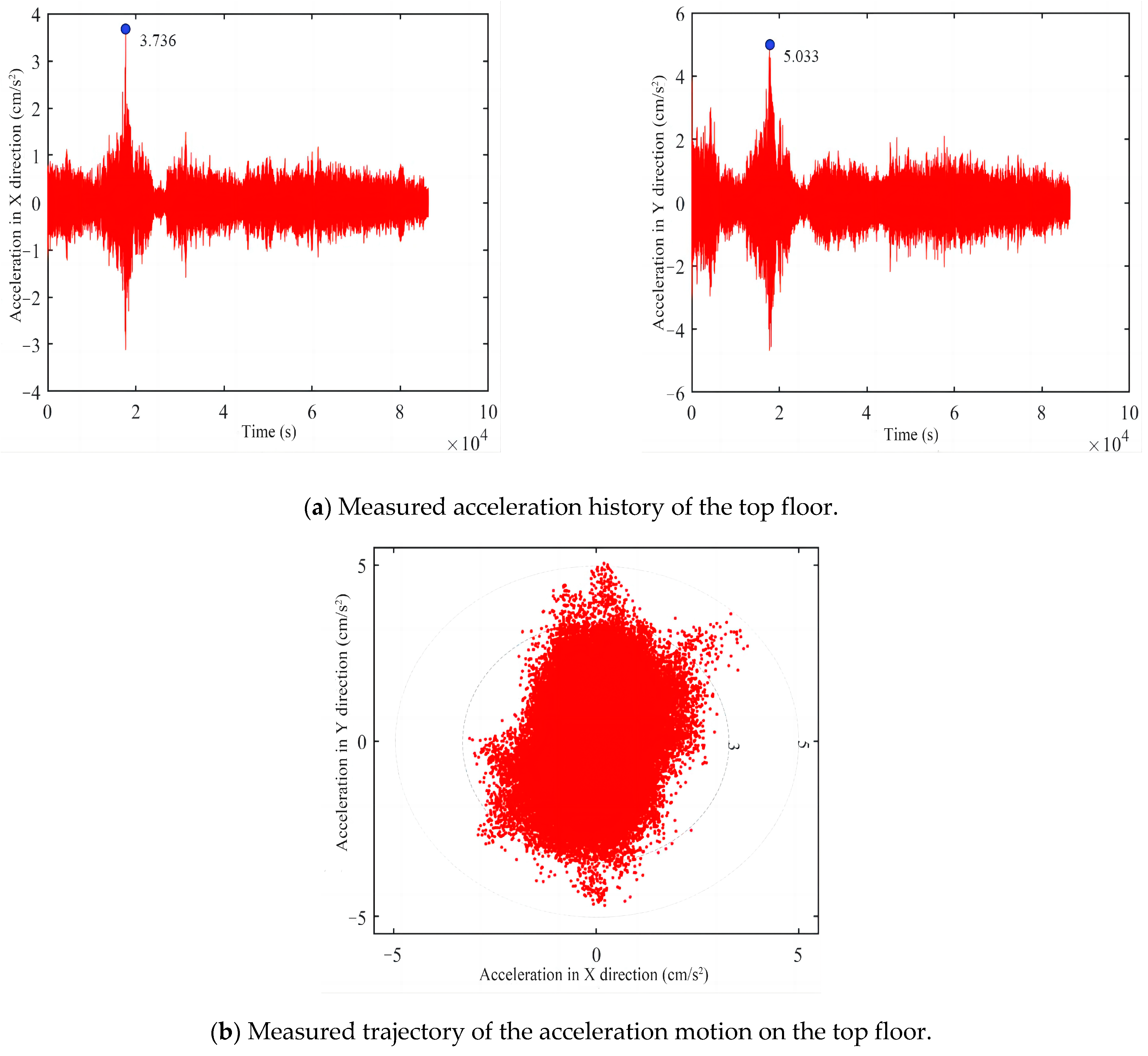
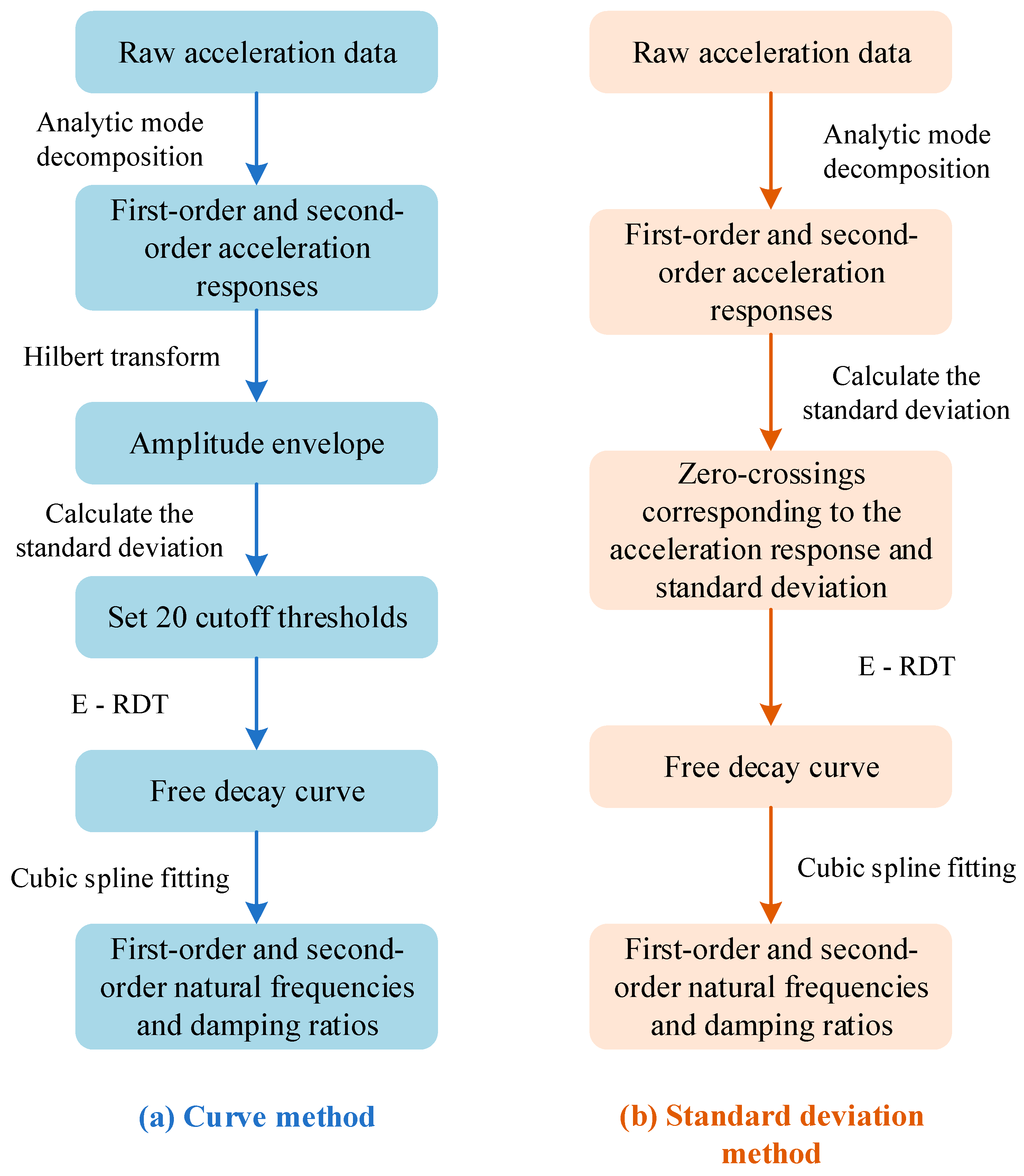

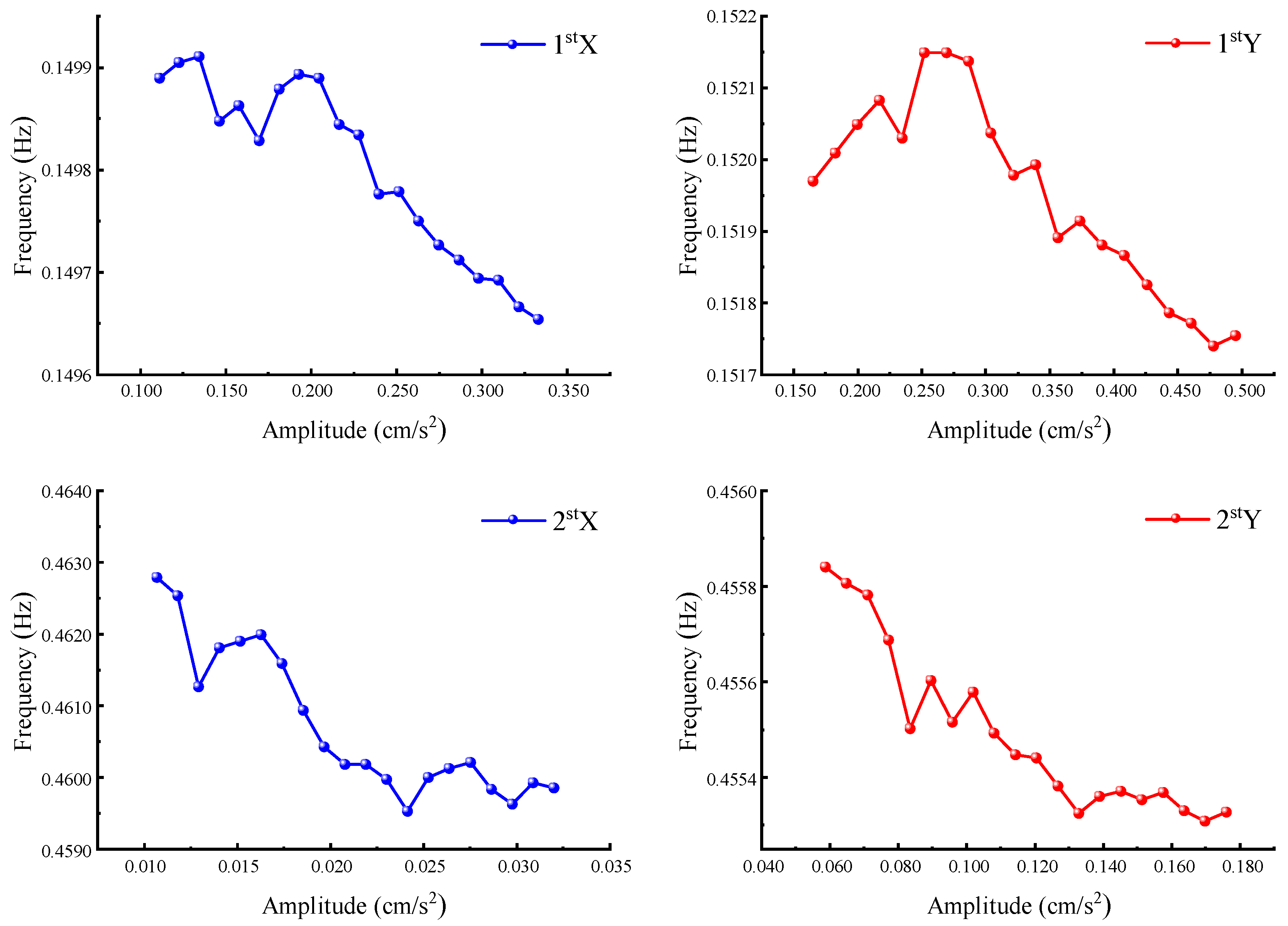

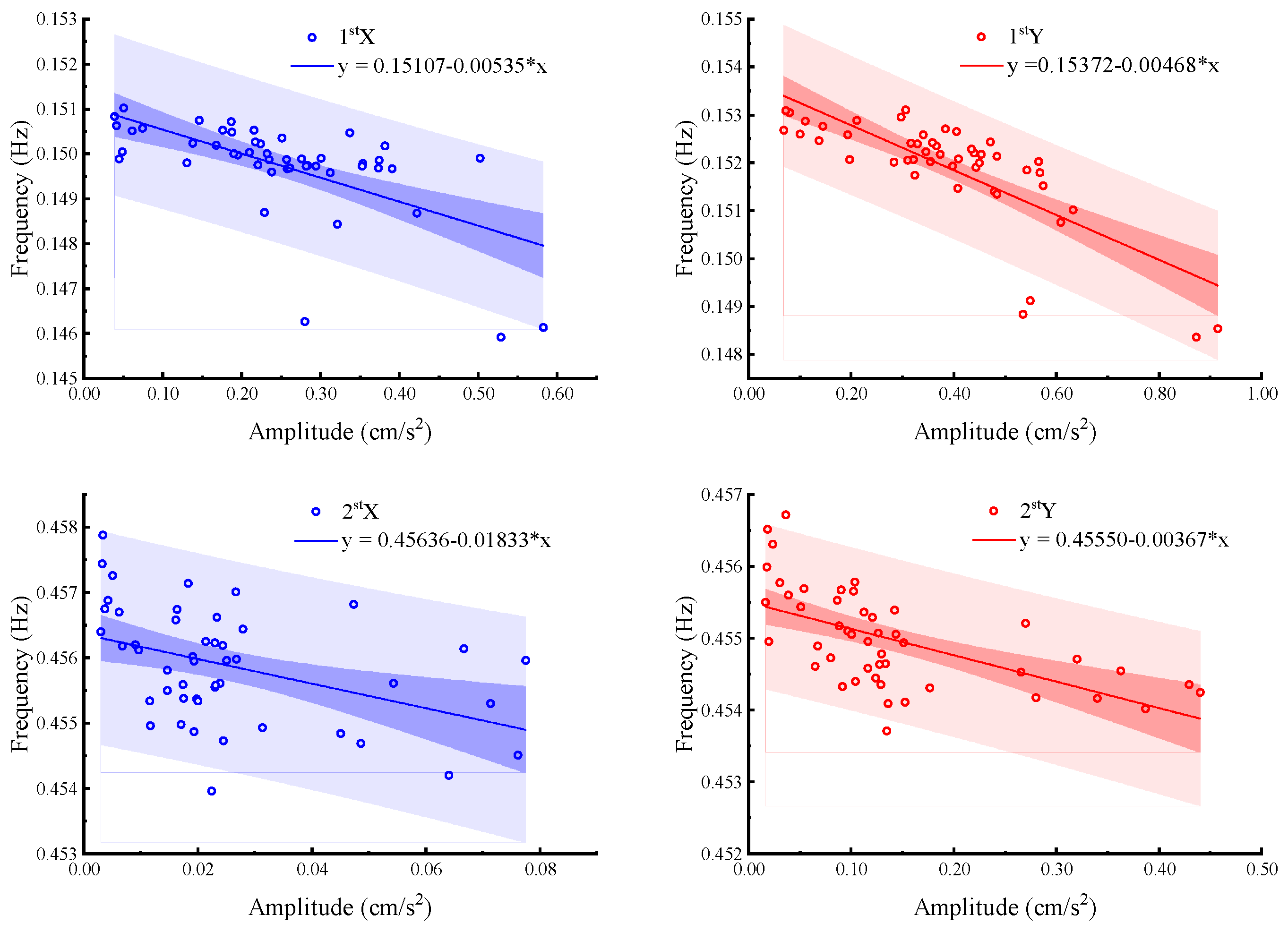
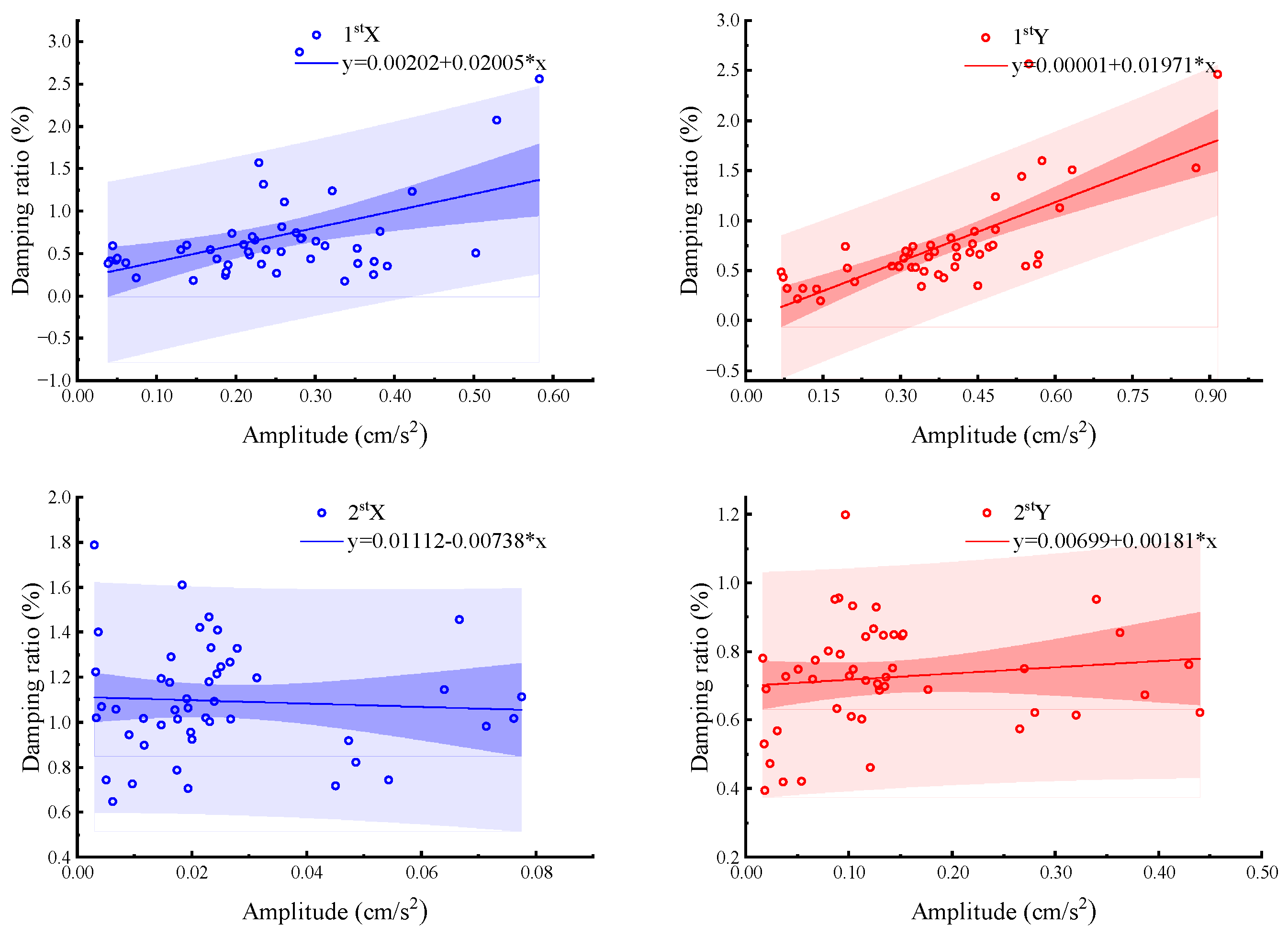
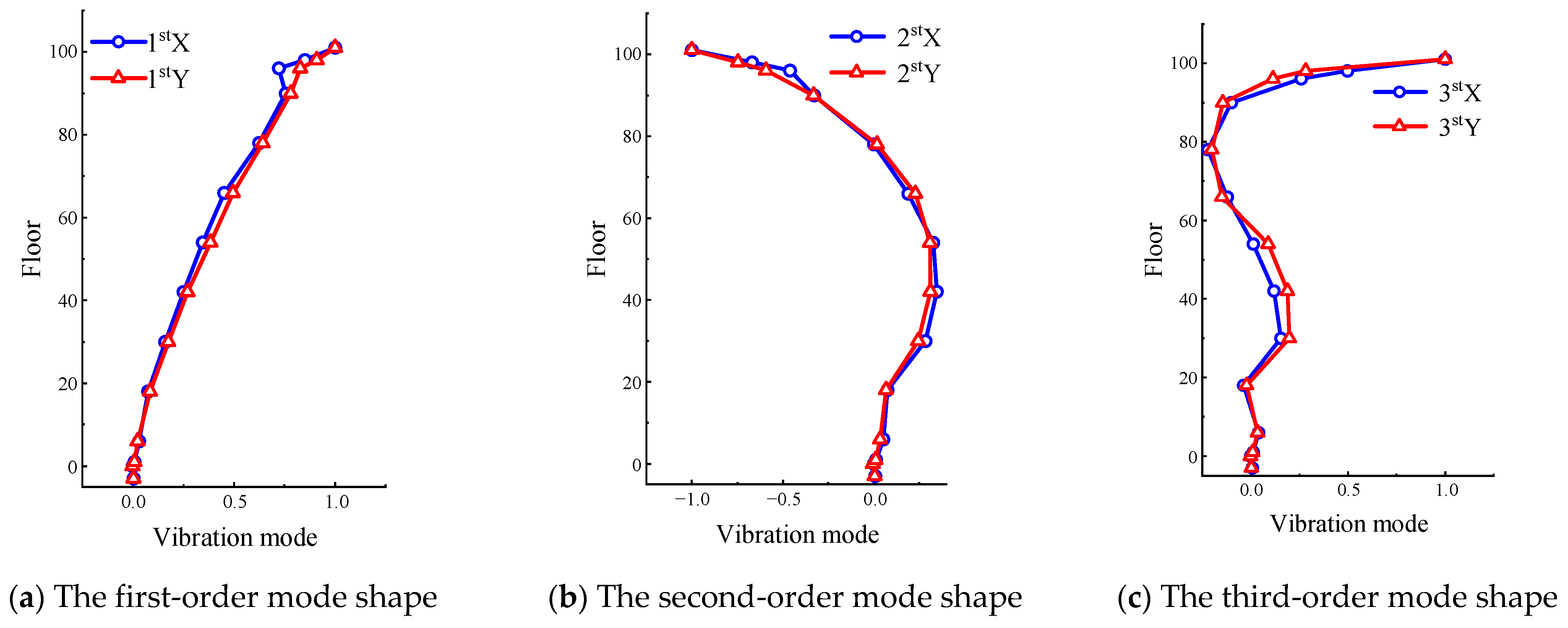
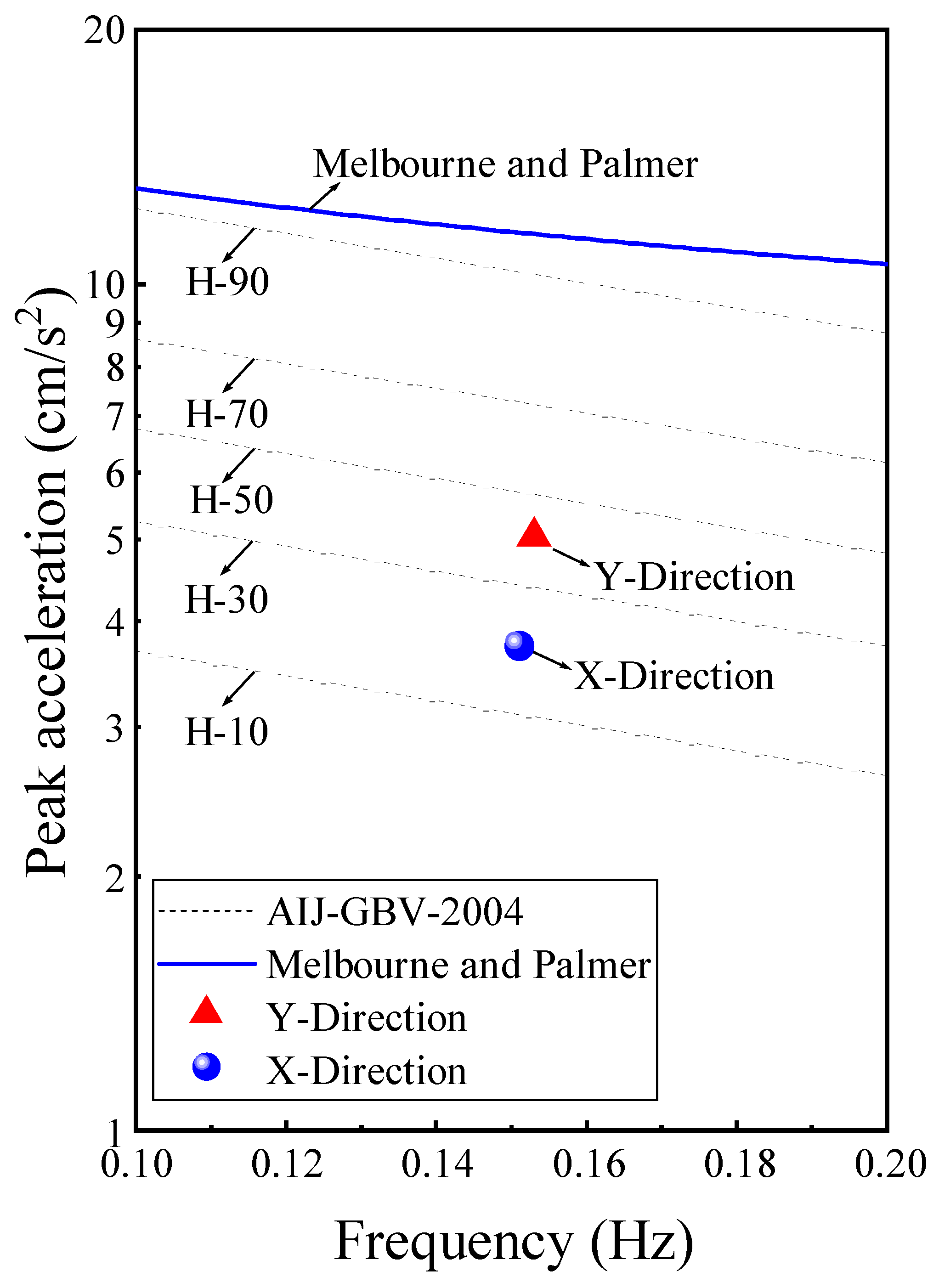
| / | The First-Order Natural Vibration Frequency (Hz) | The Second-Order Natural Vibration Frequency (Hz) | ||
|---|---|---|---|---|
| / | X-Direction | Y-Direction | X-Direction | Y-Direction |
| Peak Picking Method | 0.1525 | 0.1525 | 0.5490 | 0.5185 |
| Curve Method | 0.1499 | 0.1520 | 0.4630 | 0.4558 |
| Standard Deviation Method | 0.1511 | 0.1537 | 0.4564 | 0.4555 |
| YaJun Huang [31] | 0.1513 | 0.1535 | / | / |
| Yun Cheng He [22] | 0.1510 | 0.1530 | 0.4650 | 0.4660 |
| Yong Quan [32] | 0.1530 | 0.1550 | / | / |
| ZengShun Chen [33] | 0.1511 | 0.1526 | / | / |
| / | The First-Order Natural Vibration Frequency (Hz) (%) | The First-Order Natural Vibration Frequency (Hz) (%) | ||
|---|---|---|---|---|
| / | X-Direction | Y-Direction | X-Direction | Y-Direction |
| Curve Method | 0.788 | 0.748 | 1.527 | 0.842 |
| Standard Deviation Method | 0.176~2.876 | 0.197~2.565 | 0.646~1.788 | 0.395~1.198 |
| YaJun Huang [31] | 0.335 | 0.378 | / | / |
| Yun Cheng He [22] | 2.310 | 2.090 | 0.675 | 0.753 |
| Yong Quan [32] | 1.600 | 2.400 | / | / |
| ZengShun Chen [33] | 0.651 | 0.688 | / | / |
Disclaimer/Publisher’s Note: The statements, opinions and data contained in all publications are solely those of the individual author(s) and contributor(s) and not of MDPI and/or the editor(s). MDPI and/or the editor(s) disclaim responsibility for any injury to people or property resulting from any ideas, methods, instructions or products referred to in the content. |
© 2025 by the authors. Licensee MDPI, Basel, Switzerland. This article is an open access article distributed under the terms and conditions of the Creative Commons Attribution (CC BY) license (https://creativecommons.org/licenses/by/4.0/).
Share and Cite
Ding, Y.; Lin, L.; Xie, G.; Wang, X.; Zhao, P. A Field-Based Measurement and Analysis of Wind-Generated Vibration Responses in a Super-Tall Building During Typhoon “Rumbia”. Buildings 2025, 15, 1448. https://doi.org/10.3390/buildings15091448
Ding Y, Lin L, Xie G, Wang X, Zhao P. A Field-Based Measurement and Analysis of Wind-Generated Vibration Responses in a Super-Tall Building During Typhoon “Rumbia”. Buildings. 2025; 15(9):1448. https://doi.org/10.3390/buildings15091448
Chicago/Turabian StyleDing, Yan, Li Lin, Guilin Xie, Xu Wang, and Peng Zhao. 2025. "A Field-Based Measurement and Analysis of Wind-Generated Vibration Responses in a Super-Tall Building During Typhoon “Rumbia”" Buildings 15, no. 9: 1448. https://doi.org/10.3390/buildings15091448
APA StyleDing, Y., Lin, L., Xie, G., Wang, X., & Zhao, P. (2025). A Field-Based Measurement and Analysis of Wind-Generated Vibration Responses in a Super-Tall Building During Typhoon “Rumbia”. Buildings, 15(9), 1448. https://doi.org/10.3390/buildings15091448







